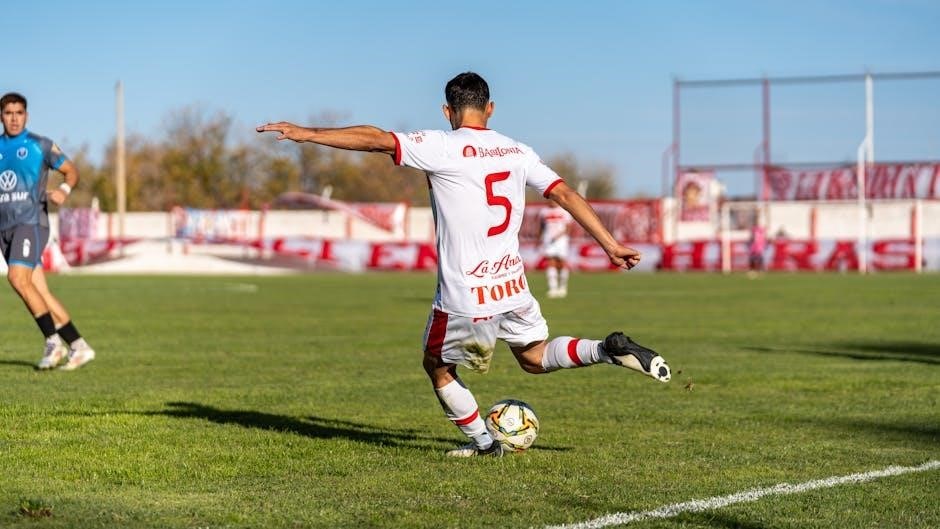Patrick Lencioni’s model highlights five dysfunctions hindering team success: absence of trust, fear of conflict, lack of commitment, avoidance of accountability, and inattention to results. These exercises, outlined in PDF guides, offer practical strategies to address each dysfunction, fostering a cohesive and high-performing team environment through structured activities and discussions.
Overview of the Five Dysfunctions of a Team
Patrick Lencioni’s model identifies five key dysfunctions that hinder team effectiveness: absence of trust, fear of conflict, lack of commitment, avoidance of accountability, and inattention to results. These interrelated issues create a pyramid, with trust at the base. Without trust, teams avoid conflict, leading to lack of commitment and accountability, ultimately causing a focus on individual goals over collective success. Addressing these dysfunctions requires intentional strategies to build trust, embrace healthy conflict, foster commitment, promote accountability, and align the team around shared objectives. This framework provides a clear path to overcoming barriers and achieving team cohesion.
Importance of Addressing Team Dysfunctions
Addressing team dysfunctions is critical for fostering collaboration, productivity, and success. Ignoring these issues leads to communication breakdowns, lack of accountability, and poor decision-making. Trust forms the foundation of effective teams, while unresolved conflicts and unclear commitments hinder progress. Without accountability, standards drop, and inattention to results diverts focus from shared goals. Overcoming these dysfunctions creates a cohesive, motivated, and results-driven team, enabling organizations to achieve their objectives efficiently. By addressing these challenges, leaders can build trust, encourage constructive conflict, and align the team around common priorities, ultimately driving long-term success and stakeholder satisfaction.
Structure of the Article
This article explores Patrick Lencioni’s Five Dysfunctions of a Team, providing a comprehensive analysis of each issue. It begins with an introduction to the model, followed by detailed sections on each dysfunction: absence of trust, fear of conflict, lack of commitment, avoidance of accountability, and inattention to results. Each section includes definitions, causes, consequences, and strategies for improvement. The article also covers practical exercises and tools, such as the Personal Histories Exercise and Team Effectiveness Exercise, to help teams overcome these challenges. Finally, it discusses implementation strategies, success measurement, and concludes with key takeaways for building a cohesive team.

Absence of Trust
Absence of trust occurs when team members hesitate to share ideas or doubts, fearing judgment. This leads to withheld feedback and unaddressed concerns, hindering collaboration and progress.
Definition and Explanation
The absence of trust is the first dysfunction, where team members lack confidence in each other’s intentions and capabilities. This leads to withholding thoughts and feelings, creating a culture of fear and disengagement. Trust is foundational, as without it, teams struggle to collaborate effectively. According to Lencioni, trust isn’t about predicting others’ behavior but about being vulnerable and open. Without trust, teams fail to tap into each other’s strengths, leading to poor communication and unresolved conflicts. Addressing this dysfunction is crucial for building a cohesive and productive team environment.
Causes of Lack of Trust in Teams
The absence of trust often stems from team members’ fear of vulnerability and reluctance to share their true thoughts and feelings. Past experiences, such as betrayal or unaddressed conflicts, can also erode trust. Additionally, unclear expectations and lack of transparency in leadership exacerbate mistrust. When individuals assume negative intentions without clarification, it creates a toxic environment. Without trust, teams struggle to collaborate, leading to disengagement and poor communication. Addressing these root causes is essential for fostering an environment where trust can grow, enabling teams to function cohesively and achieve their goals effectively.
Consequences of Absence of Trust
The absence of trust undermines team collaboration, leading to poor decision-making and ineffective communication. Without trust, team members hesitate to share concerns or admit weaknesses, fostering a culture of suspicion. This reluctance to be vulnerable prevents open dialogue, causing unresolved issues to fester. Trust gaps also lead to finger-pointing and defensiveness, stifling accountability and innovation. Ultimately, a lack of trust creates a fragmented team environment, hindering alignment and collective progress. This dysfunction lies at the core of many team failures, making it the foundation of other dysfunctions and a critical issue to address for long-term success.
Strategies to Build Trust
Building trust within a team requires intentional efforts, starting with vulnerability and openness. Leaders should model transparency and encourage team members to share personal histories, fostering deeper connections. Active listening and giving the benefit of the doubt before jumping to conclusions are critical. Recognizing and leveraging the unique skills and experiences of each team member also strengthens trust. Regular team-building exercises, such as trust-building activities, can further enhance credibility and camaraderie. When trust is established, teams can engage in productive conflict, commit to decisions, and hold each other accountable, creating a solid foundation for success.
Fear of Conflict
Fear of conflict prevents teams from engaging in productive debates, leading to poor decisions and lack of buy-in, ultimately hindering team cohesion and overall effectiveness.
Understanding the Role of Conflict in Teams
Conflict is a natural and essential component of team dynamics, driving innovation and alignment when managed effectively. However, when teams fear conflict, they avoid crucial discussions, leading to unresolved issues and poor decisions. Unaddressed conflict stifles creativity, fosters resentment, and prevents teams from reaching their full potential. Patrick Lencioni’s model emphasizes that fear of conflict is a primary dysfunction, as it hinders open communication and collaboration. By understanding the role of conflict, teams can learn to embrace it as a constructive force, fostering accountability and commitment. This understanding is key to building a cohesive and high-performing team.
Why Teams Avoid Conflict
Teams often avoid conflict due to fear of personal discomfort, reprisal, or damaging relationships. This avoidance stems from a desire to maintain artificial harmony, even when critical issues need addressing. Conflict is perceived as negative, leading to passive-aggressive behavior or unresolved tensions. Additionally, cultural or leadership styles that discourage open debate exacerbate this avoidance. Without a safe environment for constructive disagreement, teams hesitate to engage in meaningful discussions, allowing misunderstandings and unaligned priorities to persist. This reluctance to confront issues directly undermines collaboration and decision-making, ultimately hindering team performance and cohesion.
Impact of Unaddressed Conflict
Unaddressed conflict leads to unresolved issues, fostering passive-aggressive behavior and resentment among team members. This creates a toxic environment where collaboration diminishes, and decisions are often suboptimal. Without open dialogue, teams bypass crucial discussions, allowing misalignment and confusion to persist. Over time, this avoidance erodes trust and accountability, as individuals may feel their concerns are ignored. The lack of constructive debate stifles innovation and leads to disengagement. Ultimately, unaddressed conflict hinders team cohesion and performance, creating a culture where artificial harmony is prioritized over meaningful progress and collective success.
Encouraging Productive Conflict
Encouraging productive conflict involves fostering an environment where team members feel safe to express differing opinions and engage in constructive debate. Leaders should model open communication and create forums for structured discussions. Exercises like the “Team Effectiveness Exercise” or conflict resolution strategies can help teams navigate disagreements effectively. By emphasizing the value of diverse perspectives, teams can leverage conflict to drive innovation and alignment. Leaders must ensure that discussions remain focused on issues, not individuals, and that all voices are heard. This approach builds trust and ensures that conflicts lead to better decisions and stronger collaboration.

Lack of Commitment
Lack of commitment arises when team members hesitate to buy into decisions, often due to unclear expectations or unaddressed concerns, undermining team cohesion and progress.
Defining Commitment in Team Contexts
Commitment in a team context refers to the collective agreement and dedication of members to a clear direction and set of goals. It involves willingness to support decisions, even when not everyone initially agrees. Patrick Lencioni emphasizes that commitment is not about consensus but about uniting behind a common purpose. Without commitment, teams struggle with ambiguity, leading to hesitancy and reduced efficiency. Building commitment requires open dialogue, ensuring all voices are heard, and creating a shared understanding of objectives. This foundation is crucial for overcoming the third dysfunction and fostering a cohesive team environment.
Root Causes of Lack of Commitment
Lack of commitment often stems from unclear expectations and poor communication within the team. When goals and roles are ambiguous, team members hesitate to buy in. Fear of conflict also plays a role, as unaddressed disagreements lead to passive acceptance rather than genuine commitment. Additionally, without a clear understanding of how decisions are made, team members may feel disconnected from outcomes. These factors create an environment where commitment is superficial, leading to hesitation and lack of accountability. Addressing these root causes is essential to fostering a culture of true commitment and collective responsibility.
Effects of Lack of Commitment on Team Performance
Lack of commitment undermines team cohesion and progress. Without clear buy-in, decisions are met with hesitation, slowing down execution. Team members may feel disconnected from goals, leading to reduced accountability and inconsistent effort. This ambiguity hampers collaboration, as individuals prioritize personal interests over collective objectives. Over time, a culture of disengagement emerges, stifling innovation and productivity. The absence of commitment also fosters resentment among team members who feel they carry the workload. Ultimately, the team struggles to achieve its full potential, as lack of commitment creates a cycle of mediocrity and unmet expectations.
Building Consensus and Buy-In
Building consensus and buy-in is crucial for overcoming lack of commitment. This involves fostering open dialogue, encouraging active participation, and ensuring all voices are heard. Teams should clarify expectations and align individual commitments with collective goals. Leadership plays a key role in modeling vulnerability and promoting a culture of accountability. By engaging in structured exercises like the Team Effectiveness Exercise, teams can identify and address barriers to commitment. Consensus-building activities, such as collaborative decision-making and goal-setting, help ensure everyone is aligned and invested in the team’s success, reducing ambiguity and enhancing overall performance.

Avoidance of Accountability
Avoidance of accountability occurs when teams shy away from holding each other responsible, often due to interpersonal discomfort. This leads to significant underperformance and undermines team success.
Understanding Accountability in Teams
Accountability in teams refers to the collective responsibility of members to meet commitments and uphold standards. When teams avoid accountability, individuals evade responsibility, leading to poor performance and dissatisfaction. This dysfunction stems from discomfort in addressing underperformance, fostering a culture where team members fail to hold each other to shared goals. Without accountability, teams struggle to achieve results, and trust erodes further. Addressing this requires leaders to model accountability and create a safe environment for constructive feedback and mutual responsibility.
Why Teams Avoid Holding Each Other Accountable
Teams often avoid accountability due to fear of conflict and interpersonal discomfort. When members hesitate to address underperformance, it creates a culture of ambiguity and low standards. This reluctance stems from a lack of trust, as individuals may feel vulnerable to criticism or judgment. Without accountability, teams struggle to align actions with shared goals, leading to missed expectations and dissatisfaction. Leaders must address this by fostering a culture of constructive feedback and mutual responsibility, ensuring accountability becomes a collective priority rather than an avoided task.
Consequences of Avoiding Accountability
Avoiding accountability leads to a lack of pressure on underperformers, fostering resentment among team members who feel their efforts are undervalued. Without accountability, teams often fail to achieve their goals, as individuals avoid taking responsibility for their actions. This creates a culture where standards are not upheld, and individuals are not held to expectations. Ultimately, the absence of accountability hinders team performance, leading to poor outcomes and a lack of progress toward objectives.
Creating a Culture of Accountability
Building a culture of accountability involves establishing clear expectations and ensuring team members hold themselves and others to high standards. Leaders must model accountable behavior, while fostering an environment where constructive feedback is embraced. Teams should engage in exercises that promote transparency, such as regular check-ins and progress reviews. Trust is essential, as it allows individuals to address underperformance without fear of retaliation. By creating a collective commitment to accountability, teams can ensure alignment and drive toward shared goals, ultimately improving performance and outcomes.

Inattention to Results
Inattention to results occurs when team members prioritize individual goals over collective success. This dysfunction leads to poor decision-making and a lack of focus on shared objectives, hindering overall performance and accountability.
Defining Results-Oriented Teams
A results-oriented team is one that prioritizes collective goals over individual interests, ensuring alignment with organizational objectives. Such teams maintain a clear focus on outcomes, fostering accountability and collaboration. They consistently communicate expectations, track progress, and adapt strategies to achieve desired results. A results-oriented mindset ensures that all efforts contribute to the team’s shared success, minimizing distractions and enhancing overall performance. This approach requires strong leadership, clear communication, and a commitment to measurable outcomes, which are essential for overcoming the dysfunction of inattention to results.
Causes of Inattention to Results
Inattention to results often stems from a lack of clear goals, poor leadership, or individual priorities overshadowing team objectives. When teams lack accountability or fail to align actions with overarching aims, focus drifts. Additionally, a culture that emphasizes individual success over collective outcomes can distract from shared objectives. Without strong leadership to maintain direction, teams may lose sight of results, leading to underperformance and misalignment with organizational goals. Addressing these underlying issues is crucial to fostering a results-oriented mindset and overcoming this dysfunction. Clear communication and accountability are key to refocusing efforts on shared success.
Impact on Team Success
Inattention to results significantly hinders team success by diverting focus from shared goals. When individuals prioritize personal interests over collective objectives, overall performance suffers. This dysfunction leads to poor decision-making, misalignment, and a lack of accountability; Teams become disconnected from organizational priorities, causing inefficiency and stagnation. Over time, this can erode morale, as members feel their efforts are not contributing to meaningful outcomes. Ultimately, inattention to results undermines the team’s ability to achieve its purpose, leading to internal conflicts and dissatisfaction among members. Addressing this issue is critical to ensuring alignment and driving toward common objectives. Clear goals and accountability are essential.
Aligning the Team Around Common Goals
Aligning the team around common goals is essential to overcome inattention to results. Clear communication of objectives ensures everyone understands their role and contribution. Regularly reviewing progress and providing feedback helps maintain focus. Team-building exercises, such as goal-setting workshops, encourage collaboration and commitment. Leaders must ensure all members are aligned with organizational priorities and hold each other accountable. Trust and accountability form the foundation for achieving shared goals. Without alignment, teams risk fragmented efforts and missed targets. Effective goal alignment fosters unity, purpose, and ultimately, team success.

Team-Building Exercises to Overcome Dysfunctions
Team-building exercises address the five dysfunctions by fostering trust, encouraging conflict, building commitment, promoting accountability, and aligning teams around results. Activities include personal histories, trust-building games, and goal-setting workshops.
Personal Histories Exercise
The Personal Histories Exercise helps team members share personal anecdotes, fostering vulnerability and trust. Each individual discusses significant life events, revealing their values and experiences. This activity encourages deeper connections, breaks down barriers, and creates a foundation for open communication. By understanding one another on a personal level, team members gain empathy and build stronger relationships. This exercise is particularly effective in addressing the absence of trust, as it promotes transparency and vulnerability, essential for cohesive teamwork and collaboration.
Team Effectiveness Exercise
The Team Effectiveness Exercise involves assessing and discussing the team’s performance across key areas. Members evaluate their collaboration, communication, and alignment with goals. This exercise fosters open dialogue about strengths and weaknesses, encouraging accountability and commitment. By identifying areas for improvement, teams can address dysfunctions like lack of commitment and inattention to results. The exercise promotes a shared understanding of what effectiveness means, aligning the team around common objectives and enhancing overall performance. It serves as a catalyst for constructive conversations and actionable steps to overcome team challenges. Regular use of this tool ensures continuous improvement and growth.
Trust-Building Activities
Trust-building activities are essential for overcoming the absence of trust, the first dysfunction. These exercises encourage vulnerability and openness among team members. Techniques like sharing personal histories or conducting team-building workshops help individuals connect on a deeper level. By fostering an environment where members feel comfortable being vulnerable, teams can reduce resentment and improve collaboration. Trust-building activities also promote active listening and empathy, allowing team members to better understand each other’s strengths and experiences. Regular engagement in these activities strengthens interpersonal bonds and creates a foundation of trust, essential for effective teamwork and communication. These exercises are a cornerstone of team development and cohesion.
Conflict Resolution Strategies
Conflict resolution strategies address the fear of conflict, the second dysfunction. Techniques like structured debates or role-playing exercises help teams embrace productive conflict. These activities encourage open dialogue, ensuring issues are addressed constructively. By creating a safe environment for disagreement, teams can avoid artificial harmony and foster innovation. Conflict resolution exercises also teach active listening and empathy, helping members understand differing perspectives. Regular practice in resolving conflicts strengthens team cohesion and leads to better decision-making. These strategies are crucial for transforming fear of conflict into a catalyst for collaboration and growth, enhancing overall team performance and results.
Commitment and Accountability Exercises
Commitment and accountability exercises aim to address the third and fourth dysfunctions: lack of commitment and avoidance of accountability. These exercises involve setting clear expectations and encouraging team members to hold one another responsible for their actions. Activities such as establishing shared goals, creating accountability charts, and conducting regular progress reviews help foster a culture of commitment. Additionally, exercises like “public declarations” ensure team members openly commit to decisions, promoting unity and reducing ambiguity. By fostering accountability, teams build trust and ensure everyone contributes to achieving common objectives, leading to improved collaboration and overall performance.
Results-Focused Team Activities
Results-focused team activities are designed to combat the fifth dysfunction: inattention to results. These exercises help align the team around common goals, ensuring everyone understands how their efforts contribute to the broader objectives. Activities include defining and aligning on clear outcomes, creating visual progress-tracking tools, and conducting regular goal-setting workshops. Team members also engage in exercises to identify how their individual tasks impact the team’s results, fostering a collective focus on success. Celebrating milestones and reviewing outcomes together reinforces the importance of prioritizing results, driving the team toward achieving its shared vision and objectives effectively.
Implementing the Five Dysfunctions Model
Leadership must create a clear plan, monitor progress, and foster accountability while addressing each dysfunction through tailored strategies and team-building exercises.
Leadership’s Role in Addressing Dysfunctions
Leadership plays a vital role in addressing team dysfunctions by fostering trust, encouraging productive conflict, and ensuring commitment. Leaders must hold teams accountable and align goals with organizational objectives. They should model vulnerability to build trust and provide constructive feedback to guide improvement. By promoting a culture of accountability and focusing on collective results, leaders can overcome dysfunctions and drive team success.
Creating a Plan to Overcome Dysfunctions
Developing a structured plan is essential to address team dysfunctions. Begin by identifying specific issues through assessments and feedback. Prioritize areas needing improvement, such as building trust or enhancing accountability. Assign clear actions and timelines, ensuring each team member understands their role. Regular progress reviews and adjustments are crucial to maintain momentum. Incorporate exercises like personal histories or conflict resolution to foster collaboration. The plan should align with organizational goals, ensuring a cohesive and results-driven approach to overcoming dysfunctions and achieving long-term team success.
Monitoring Progress and Adjusting Strategies
Regularly assessing team improvement is vital to ensuring the effectiveness of dysfunction-overcoming efforts; Leaders should implement progress-tracking mechanisms, such as feedback sessions and performance metrics, to evaluate advancements. Adjust strategies based on observed outcomes, ensuring alignment with team goals. Encourage open communication to identify emerging challenges and refine approaches accordingly. Flexibility is key to sustaining momentum, as team dynamics and organizational needs may evolve. Continuous monitoring ensures that efforts remain focused and impactful, fostering a culture of adaptability and growth; This iterative process is essential for long-term team health and success.

Measuring Success
Assessments and feedback loops help gauge progress in overcoming team dysfunctions. Regular evaluations ensure alignment with goals, fostering transparency and accountability to achieve lasting success.
Assessing Team Health
Evaluating team health involves identifying and addressing the five dysfunctions through structured assessments and feedback. Tools like the Team Effectiveness Exercise and Personal Histories Exercise help teams understand their strengths and weaknesses. These exercises foster open dialogue, encouraging members to share perspectives and vulnerabilities, which is crucial for building trust. By regularly assessing team dynamics, leaders can pinpoint areas needing improvement, such as fear of conflict or lack of commitment, and implement targeted strategies to enhance collaboration and accountability.
Progress is measured by observing behavioral changes and improved results, ensuring teams stay aligned with common goals and maintain a focus on collective success rather than individual interests.
Using Feedback to Improve
Feedback is a critical component in overcoming team dysfunctions, enabling members to address weaknesses and build on strengths. Exercises like the Team Effectiveness Exercise and 360-Degree Feedback encourage open communication, helping teams identify areas for growth. By fostering a culture where feedback is welcomed and acted upon, leaders can promote transparency and accountability. Regularly incorporating feedback loops ensures continuous improvement, strengthens trust, and aligns the team with shared goals. This iterative process not only enhances individual performance but also elevates overall team cohesion and results.
Tracking Progress Over Time
Regularly monitoring progress is essential to ensuring sustained improvement in addressing team dysfunctions. Tools like Team Assessment and progress tracking exercises help measure advancements. By maintaining a consistent focus on feedback and accountability, teams can identify areas of improvement and reinforce positive changes. This iterative process ensures that efforts to build trust, encourage conflict, and align on goals remain impactful. Over time, tracking progress fosters a culture of continuous improvement, enabling teams to achieve and maintain high performance levels. Consistent monitoring also helps leaders adjust strategies to meet evolving team needs.
Overcoming the five dysfunctions builds a cohesive team, fostering trust, healthy conflict, commitment, accountability, and focus on results, essential for achieving lasting success through targeted exercises and strategies.
Patrick Lencioni’s five dysfunctions of a team—absence of trust, fear of conflict, lack of commitment, avoidance of accountability, and inattention to results—hindering team success. Practical exercises, such as Personal Histories and Team Effectiveness, help address these issues. Building trust fosters vulnerability, while constructive conflict enhances decision-making. Securing commitment ensures alignment, and accountability drives responsibility. Ultimately, focusing on shared results unites the team. Overcoming these dysfunctions through targeted exercises promotes a cohesive, productive, and results-oriented team culture, as outlined in Lencioni’s model.
Final Thoughts on Building a Cohesive Team
Overcoming the five dysfunctions—absence of trust, fear of conflict, lack of commitment, avoidance of accountability, and inattention to results—is essential for building a cohesive team. By fostering trust, encouraging productive conflict, securing commitment, promoting accountability, and focusing on shared results, leaders can create an environment where team members thrive. Practical exercises, such as Personal Histories and Team Effectiveness, help bridge gaps and strengthen relationships. Ultimately, a cohesive team requires courage, persistence, and intentional effort to address these dysfunctions, leading to greater collaboration, productivity, and success.
